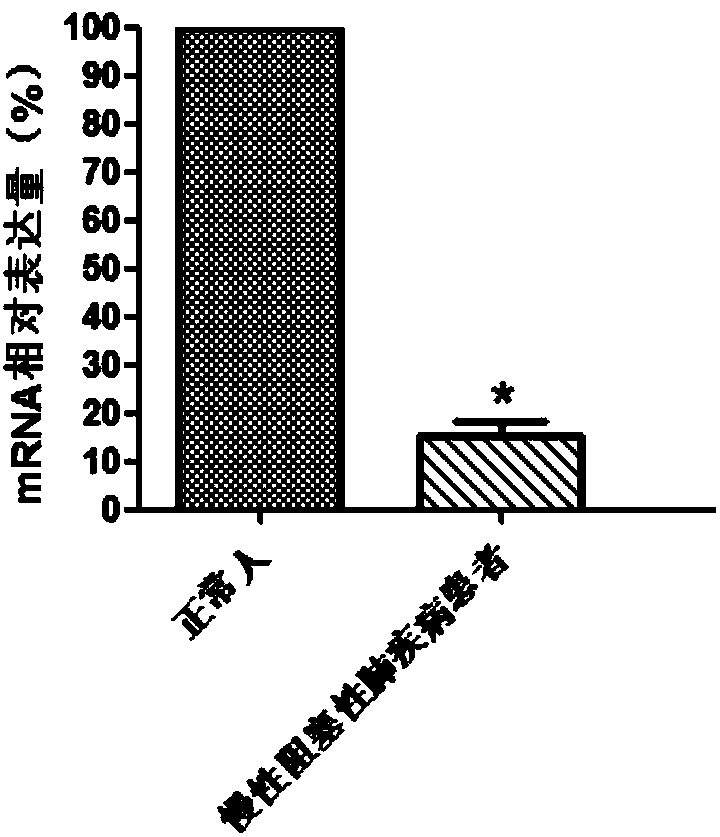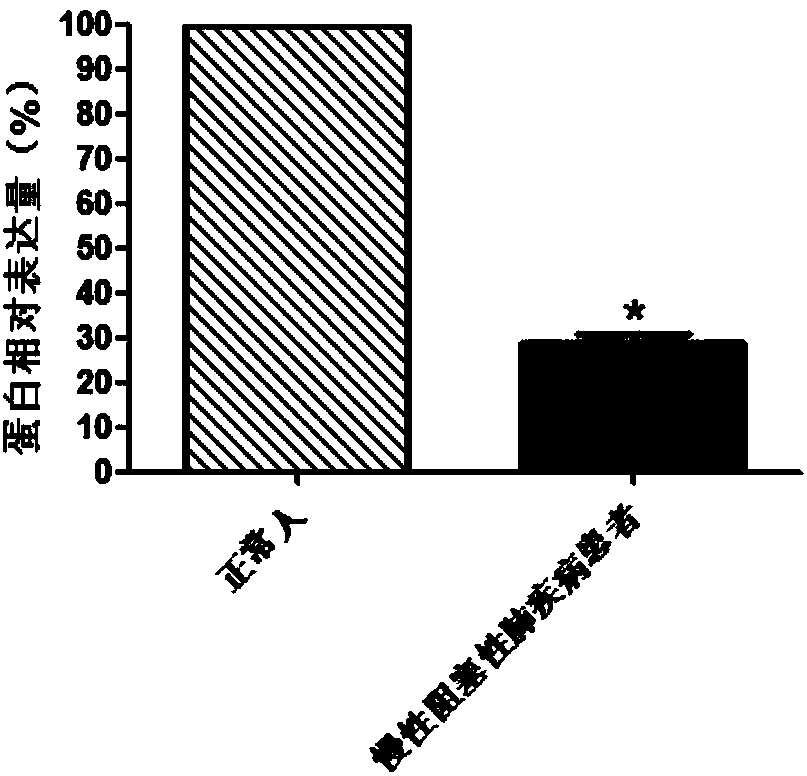SHISA4 serving as biomarker for early diagnosis of chronic obstructive pulmonary disease
A chronic obstructive pulmonary and material technology, applied in disease diagnosis, biological testing, biomaterial analysis, etc., can solve problems such as clinical misdiagnosis, and achieve the effect of improving survival rate
- Summary
- Abstract
- Description
- Claims
- Application Information
AI Technical Summary
Problems solved by technology
Method used
Image
Examples
Embodiment 1
[0041] Example 1 Screening of differentially expressed genes in patients with chronic obstructive pulmonary disease and normal people
[0042] 1. Clinical research objects:
[0043] Five patients with chronic obstructive pulmonary disease were selected, including 2 males and 3 females, ranging in age from 50 to 79 years old. The diagnostic criteria were in compliance with the "Chronic Obstructive Pulmonary Disease Diagnosis and Treatment Norms" revised in 2007.
[0044] Diagnostic criteria: Any patient suffering from dyspnea, chronic cough or sputum, and a history of exposure to risk factors, lung function tests show that after inhalation of bronchodilators, there is airflow limitation, which can be diagnosed as COPD.
[0045] Exclusion criteria: ①Patients with other lung diseases, such as bronchial asthma, pulmonary fibrosis, lung cancer, etc.; ②Patients with other infections; ③With severe cardiovascular and cerebrovascular diseases, diabetes, blood system diseases, malignant tumors, ...
Embodiment 2
[0085] Example 2 QPCR verification of the relationship between candidate genes and chronic obstructive pulmonary disease
[0086] Based on the results of previous high-throughput sequencing and according to the size of P value, we selected SHISA4 gene (its expression is down-regulated in patients with chronic obstructive pulmonary disease) for verification.
[0087] 1. Research objects:
[0088] According to the method of Example 1, 45 patients with chronic obstructive pulmonary disease and 35 normal persons were selected.
[0089] 2. Extraction of total RNA from blood
[0090] Use Biotech blood RNA extraction kit to extract total RNA from blood:
[0091] (1) Take 250μl (or 0.25g) of whole blood into the RNase-Free filter column, centrifuge at 13000rpm for 2 minutes, collect the lower liquid, and add 0.75ml lysis buffer RLS.
[0092] (2) The homogenized sample was shaken vigorously and mixed, and incubated at 15-30°C for 5 minutes to completely decompose the ribosome.
[0093] (3) Optional...
Embodiment 3
[0109] Example 3 Western blotting experiments to verify the expression products of differentially expressed genes in patients with chronic obstructive pulmonary disease and normal people
[0110] 1. Clinical object: Same as Example 2.
[0111] 2. Separation of monocytes
[0112] For patients with chronic obstructive pulmonary disease and normal people, take 10ml of venous blood, inject it into a sterile vial containing heparin, and shake it gently after capping. Use a sterile pipette to add an equal volume of HBSS (NaCl 8.0g, Na 2 HPO 4 0.132g, KH 2 PO 4 0.06g, KCl 0.4g, phenol red 1ml, NaHCO 3 0.35g, D-glucose 1.0g, dissolved in 1000ml double distilled water) to reduce the aggregation of red blood cells. Aspirate 8ml of lymphocyte layering solution and place it in a 50ml centrifuge tube. Add diluted blood slowly along the tube wall to keep the interface clear. Do not mix the two. Centrifuge at 2000r / min for 30min at 20℃. Carefully draw the layered solution and connect it with plas...
PUM
 Login to View More
Login to View More Abstract
Description
Claims
Application Information
 Login to View More
Login to View More - R&D
- Intellectual Property
- Life Sciences
- Materials
- Tech Scout
- Unparalleled Data Quality
- Higher Quality Content
- 60% Fewer Hallucinations
Browse by: Latest US Patents, China's latest patents, Technical Efficacy Thesaurus, Application Domain, Technology Topic, Popular Technical Reports.
© 2025 PatSnap. All rights reserved.Legal|Privacy policy|Modern Slavery Act Transparency Statement|Sitemap|About US| Contact US: help@patsnap.com


